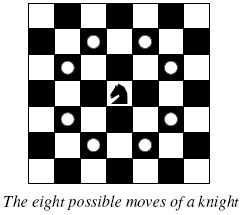A Knight's Journey
| Time Limit: 1000MS | Memory Limit: 65536K | |
| Total Submissions: 48296 | Accepted: 16393 |
Description
 Background
Background
The knight is getting bored of seeing the same black and white squares again and again and has decided to make a journey
around the world. Whenever a knight moves, it is two squares in one direction and one square perpendicular to this. The world of a knight is the chessboard he is living on. Our knight lives on a chessboard that has a smaller area than a regular 8 * 8 board, but it is still rectangular. Can you help this adventurous knight to make travel plans?
Problem
Find a path such that the knight visits every square once. The knight can start and end on any square of the board.
Input
The input begins with a positive integer n in the first line. The following lines contain n test cases. Each test case consists of a single line with two positive integers p and q, such that 1 <= p * q <= 26. This represents a p * q chessboard, where p describes how many different square numbers 1, . . . , p exist, q describes how many different square letters exist. These are the first q letters of the Latin alphabet: A, . . .
Output
The output for every scenario begins with a line containing "Scenario #i:", where i is the number of the scenario starting at 1. Then print a single line containing the lexicographically first path that visits all squares of the chessboard with knight moves followed by an empty line. The path should be given on a single line by concatenating the names of the visited squares. Each square name consists of a capital letter followed by a number.
If no such path exist, you should output impossible on a single line.
If no such path exist, you should output impossible on a single line.
Sample Input
3 1 1 2 3 4 3
Sample Output
Scenario #1: A1 Scenario #2: impossible Scenario #3: A1B3C1A2B4C2A3B1C3A4B2C4
Source
TUD Programming Contest 2005, Darmstadt, Germany
代码:
dfs+字典排序(方向!dfs过程!)
#include<cstdio>
#include<cstring>
using namespace std;
int dx[8]={-1,1,-2,2,-2,2,-1,1};
int dy[8]={-2,-2,-1,-1,1,1,2,2};
struct node
{
int x;
int y;
} a[111];
int vis[1111][1111];
int t,p,q;
int flag;
void dfs(int x,int y,int step)
{
vis[x][y]=1;
a[step].x=x;
a[step].y=y+'A'-1;
if(step==p*q)
{
flag=1;
return ;
}
for(int i=0; i<8; i++)
{
int nex=x+dx[i];
int ney=y+dy[i];
if(nex>=1&&nex<=p&&ney>=1&&ney<=q&&vis[nex][ney]==0&&!flag)
{
dfs(nex,ney,step+1);//看下一个位置
vis[nex][ney]=0;//撞完南墙回到这里,把刚用过的数字收回
}
}
// vis[x][y]=0;
}
int main()
{
scanf("%d",&t);
for(int i=1; i<=t; i++)
{
flag=0;
scanf("%d%d",&p,&q);
memset(vis,0,sizeof(vis));
dfs(1,1,1);
printf("Scenario #%d:\n",i);
if(flag)
{
for(int i=1; i<=p*q; i++)
{
printf("%c%d",a[i].y,a[i].x);
}
printf("\n");
}
else
{
printf("impossible\n");
}
if(i!=t)
printf("\n");
}
}





 本文探讨了一个经典的计算机科学问题——骑士周游问题。该问题要求在一个指定大小的国际象棋棋盘上找到一条路径,使得骑士能够恰好访问每个方格一次。文章提供了问题描述、输入输出格式、样例以及一种基于深度优先搜索的解决方案。
本文探讨了一个经典的计算机科学问题——骑士周游问题。该问题要求在一个指定大小的国际象棋棋盘上找到一条路径,使得骑士能够恰好访问每个方格一次。文章提供了问题描述、输入输出格式、样例以及一种基于深度优先搜索的解决方案。
















 1756
1756

 被折叠的 条评论
为什么被折叠?
被折叠的 条评论
为什么被折叠?








